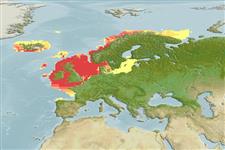| Native range | All suitable habitat | Point map | Year 2100 |

|
| This map was computer-generated and has not yet been reviewed. |
| Microstomus kitt AquaMaps Data sources: GBIF OBIS |
Length at first maturity
Lm 31.5, range 20 - 30 cm
Human uses
मात्स्यिकी: व्यापारिक; जलजीवालय: सार्वजनिक लजीवालय
Phylogenetic diversity index
(Ref. 82805)
PD50 = 0.5625 many relatives (e.g. carps) 0.5 - 2.0 few relatives (e.g. lungfishes)
Trophic Level
(Ref. 69278)
3.2 ±0.33 se; Based on food items.
लौटाव
(Ref. 69278)
माध्यम, न्यूनतम जनसंख्या दुगनी होने का समय 1.4 - 4.4 वर्ष। (K=0.08-0.42; tm=3-6; tmax=23)